If any of you have ever shared a meal with me that included pork, you've probably suffered through my proclamations of how pigs are heavenly creatures given to us by a god who really takes care of his homies. It's true, they essentially are garbage disposals that can't get enough of everything we can't and wont, and when they are done processing all of that, we can then eat them. It's a fantastic way to reuse calories we abandon to waste. Not only are they incredibly pragmatic, they also taste positively divine in every way. Pigs, chickens, fish, these are all fantastic creatures that we should eat more of rather than continue our silly affair with cows. In more sensible countries, pork is far popular than cow. Cow has the appeal of being a high class meat, but realistically it can't compete with the greater ease of raising pigs and the breadth of culinary uses our chubby friends provide us.
In almost every market in Ecuador, the upper floors are dominated by roasted pigs providing lunch to hungry market goers. These pigs have been roasted in an oven or over a grill, while a mixture of spices and fat is repeatedly applied to give the skin that brown color. The wonderful thing about this slower process of cooking is that it separates the skin from the meat underneath, similar to a process used to prepare my favorite dish, Beijing duck. This skin becomes very crispy and unbelievably flavorful. The fat between the skin and the meat is mostly dissolved into the meat below flavoring it even further. This process creates one hell of a lunch.
Here the woman is cutting portions of the skin and meat to prepare for a plate.
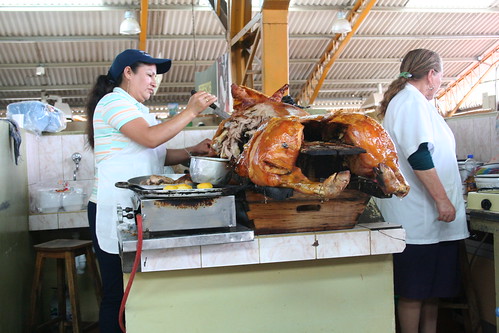
CLICK THESE PICTURES FOR LARGER IMAGES YOU WONT REGRET IT.
The final plate one is served is not just pork. The bottom is mote or hominy. This is a very basic and common carbohydrate in Ecuadorian cooking. The pork is dumped on top this and garnished with lots of onions and tomatoes. These plates always come with one or two potato and cheese pancakes. These pan fried nuggets of joy accompany a wide variety of Ecuadorian dishes. You can then add some vinegar to the pork if thats your thing (it certainly is mine) or you can add a little hot sauce (not really hot) made from mild peppers and something called a tree tomato.
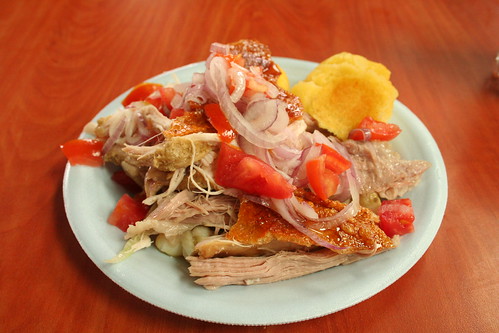
The result of this is that first thing tomorrow for lunch I'm going to the market and ordering this. I'm not kidding, the hardest thing about writing about food is that it just makes me miss these past meals.
Pig has many applications due to the strong flavor its fat can provide to just about anything. The savoriness flavor Chinese food theory identifies is perhaps best applied by pork fat. This next type of food strongly benefits from this.
Tamales are an ubiquitous food found all across North and South America. The fantastic thing about tamales is that they enjoy a regional variety that makes culinary travel quite exciting. The only other food creation that may have more regional variety is the sandwich. I am a big fan of Mexican tamales for numerous reasons primarily relating to spices, but Ecuadorian tamales compete quite strongly in this category. Ecuadorian tamales differ primarily from Mexican tamales in the sense that they don't use masa and instead rely on a sweeter and younger type of corn. Ecuadorian tamales are usually filled with a multitude of things, beginning with chicken or pork, and garnished by eggs, raisins, peas, and peppers.
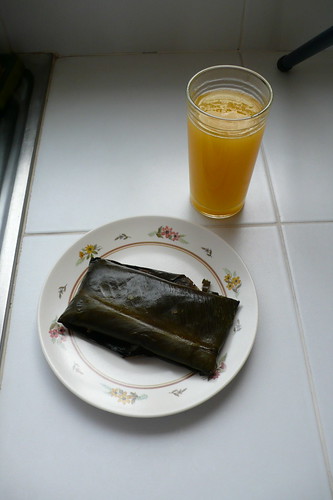
Instead of a corn husk they are wrapped in the leaves of a lily type plant called a Canna. They are steamed in large pots specifically used for this purpose, and as such, they are easily reheated in a microwave with minimal effort and loss of quality.
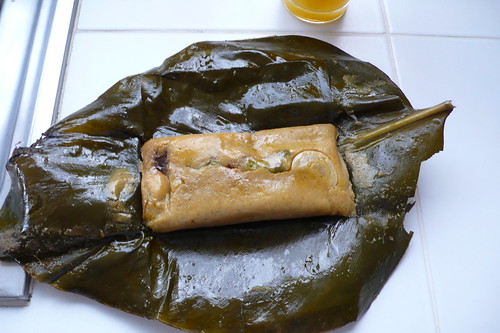
The flavor of the corn mixture is slightly sweet and always very moist. This is in comparison with the tamale's sweet cousin the humita. I like to add heat with some hot sauce but the tamale, especially the pork tamales really pack quite a bit of flavor alone. It is common to enjoy tamales for Christmas and I must say, it was the part of this last Christmas dinner I enjoyed the most. Here is a better view of the interior.
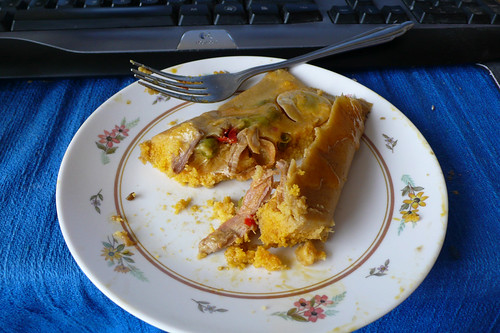
The food I have been chasing today and craving for the past 2 days, however, has been saved for last.
Ceviches are native to the area. While many associate Ceviches and their origin with Peru, Ecuador also has a potential claim. It likely originated with the Incans and originally was "cooked" with a mixture called chicha or tumbo, marinades made from fruits, not citrus as is done today. This was because citrus was a product of the Columbian exchange, the largest biological interchange of species in human history. After the spanish introduced citrus to the new world, ceviche transformed into the dish it is today.
Ceviche is quite unique in that one doesn't cook the meat with heat, but rather with the acid of citrus. This chemical transformation is very similar to the process which heat transforms meat, specifically the proteins. As a result the texture transforms giving it the mouth feel of a cooked type of seafood. It is important to note however that citric acid doesn't kill bacteria in the way that heat does, and as a result it is important to use a fresh source of seafood.
This makes the next dish a slightly risky but remarkably rewarding creation. Ceviche de conches is what kindled my newfound love for ceviche. Clams are bottom dwelling creatures which further demands stringent sanitary control in order to be safe. The final product, however, is divine. Ceviche de conches typically takes on a dark color of the specific clams used. Garlic, limes, tomatoes, salt, cilantro, onions, and olive oil are the primary ingredients aside of course from the clams. Tonight I set off to find a good example of this dish. At first I was thinking I might go to the sketchy place a few doors down, but fortunately common sense prevailed and I spent the next hour or so walking around looking for a place I felt I could trust not to kill me. Shrimp ceviche is much more common because it is easier and a lot safer to make. It was difficult to find a good place that both served it and didn't make me fear for my gastrointestinal well being. The final result is this beautiful creation.

I feel the appearance of this dish doesn't "translate" as well as I claimed food does above. To the person who has never had something like this, it looks a little creepy, and perhaps entirely unappetizing. I'm a fairly adventurous person but clam ceviche never really appealed to me the first time I saw it. Now however, that dark almost purple color of the broth now inspires the hour long trek to find a quality dish of the stuff.
I can't really describe the flavor. If you like clams you might be able to guess at it, but these specific types of clams common in Ecuador aren't found to commonly in the United States and taste much different. In regards to this dish, you will simply have to come visit and taste it yourself.

Andy, those tamales are killing me! I want one so bad. I wonder if we can make them here. Your food descriptions remind me of Alton Brown on the Food Channel. Love the photos.
ReplyDeleteMama